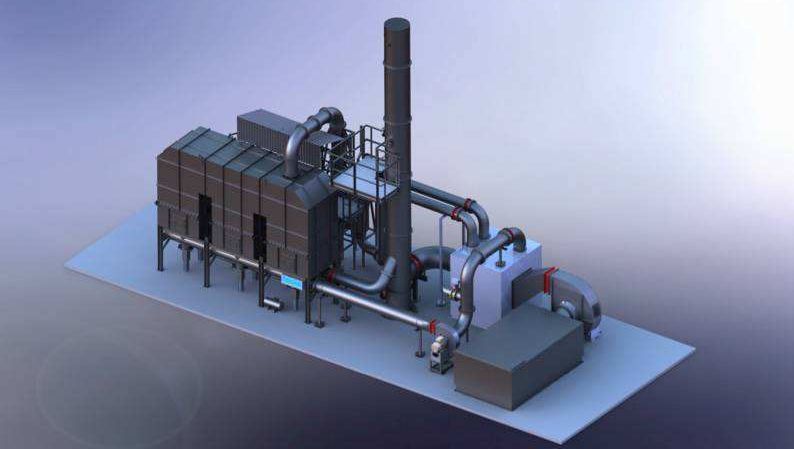In developed countries in Europe and the United States, RTO has many years of experience in the industrial field. On the one hand, it has left valuable experience for many domestic enterprises, but there are also some problems. Find out.
Advantages of RTO:
1.It is suitable for the treatment of almost all organic waste gas, and the thermal efficiency is extremely high, especially when the concentration of organic matter in the waste gas is suitable, it can realize self-heating operation without adding auxiliary fuel, so as to achieve energy saving and emission reduction and meet the emission requirements;
2.Secondly, when the concentration of exhaust gas is high, heat can be recovered to compensate or recover investment;
3.Finally, the operation of RTO is simple, reliable and requires little maintenance;
So what are the problems of RTO that we need to solve?
1.Burn-out system: In order to prevent the condensation and accumulation of organic droplets (paint) and high-boiling hydrocarbons in the organic waste gas at the cold end of the regenerator bed and depositing on the surface of the regenerator, the bed is blocked. Many RTO devices are equipped with burnout systems, which are also ovens. Most of them use high-mix purification airflow to remove pollutant deposits or coking in the regenerator online or periodically.
2.Siloxane problem: In recent years, it has been found that there are siloxanes in the exhaust gas emissions of many enterprises, especially when dealing with the exhaust gas discharged from the production process of plastics, wood processing, semiconductor processing, silicone rubber, food additives, detergents, etc. There is a volatile organosilicon compound gas. When processing this organosilicon compound-containing waste gas, silicon is oxidized to SIO2 at high temperature and is in a glass state. It can make the ceramic saddle ring agglomerate and block the small holes filled by the honeycomb, thereby Causes the pressure drop of the bed to rise, and even causes the device to stop working due to inoperability. For this reason, many environmental protection companies (including Ausi Environmental Protection) have developed various RTO devices to prevent and remove SIO2. For example, the exhaust gas is first burned in a combustion chamber, and SIO2 is initially removed. When entering the RTO device, a moving bed can also be used to flush or replace the regenerator at any time during the operation of the RTO, or do some work on the regenerator technology. technological innovation, etc.
3.Corrosion problem: Another prominent problem is the corrosion problem. Due to the presence of corrosive gas in the raw waste gas, it condenses in the conveying pipeline due to low temperature, and the accumulation causes corrosion to the material. Another is the treatment of chlorinated hydrocarbons. HC1 and CL2 are generated due to the oxidation reaction of VOCs, causing corrosion of certain parts or exhaust pipes. The solution is to appropriately increase the exhaust gas or exhaust temperature, and use corrosion-resistant high-alloy steel materials, in addition. Dioxins are produced after incineration of the exhaust gas containing halogenated hydrocarbons. The residence time of the exhaust gas in the RTO system and the quenching device of the exhaust gas are the current standard measures to reduce the generation of dioxins.
4.The problem of RTO renewal and transformation: the RTO of developed countries in Europe and the United States has been in operation for 30-40 years, and the domestic market has only been launched in large quantities after 2015. Currently, it is facing the renewal and upgrading. The general trend is: to transform on the basis of the original technology , In addition to further improving the automatic monitoring system, the original ceramic saddle ring is mainly replaced by honeycomb ceramic to expand the processing capacity and improve thermal efficiency, or reduce the pressure drop to save the power consumption of the fan, and under possible conditions, add a A layer of catalyst is used to reduce the operating temperature and further achieve the effect of energy saving and emission reduction.
At present, it has only been a few years since a large number of RTOs have been on the market, but there is a lot of room for development. In the future, RTO can not only treat the waste gas of organic compounds, but also its heat storage technology can be used in all industrial furnace fields to improve thermal efficiency. It can be expected: RTO is not only used for the purification of volatile organic compound pollution, but will be further expanded to other fields.
Methane is a greenhouse gas, and its greenhouse effect is 21 times that of carbon dioxide. RTO can treat the coalbed methane emitted by coal mines, which can not only reduce the greenhouse effect, but also generate hot water or electricity, so RTO has a wide range of uses.


